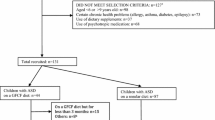Abstract
Dietary intake was assessed in a sample population of 40 autistic and 34 control children with a 7-day diet record kept by the parent or primary caregiver. A questionnaire was completed by each participant to obtain descriptive data on nutrition and health issues, attitudes and beliefs about nutrition, and nutrition knowledge. The autistic children had significantly greater intake of all nutrients with the exception of vitamins A and C, and fat; overall adequacy of diets was similar for both groups. Parent/primary caregivers of autistic children reported a more positive belief in the relationship between diet and behavior, and a more positive attitude about the importance of nutrition. A higher incidence of food cravings, pica, and perceived eating problems were reported by the parent/caregivers of autistic children.
Similar content being viewed by others
References
Anastasi, A. (1982).Psychological testing (5th ed.). New York: Macmillan.
Blood, R., & Wolfe, D. (1960).Husbands and wives: The dynamics of married life (p. 21). Glencoe, Illinois: Free Press.
Burt, J. V., & Hertzler, A. A. (1978). Parental influence on the child's food preference.Journal of Nutritional Education, 10, 127–128.
Clancy, H., Entsch, M., & Rendle-Short, J. (1969). Infantile autism: The correlation of feeding abnormalities.Developmental Medicine and Child Neurology, 11, 569–578.
Culley, W. J., & Middleton, T. O. (1969). Caloric requirements of mentally retarded children with and without motor dysfunction.Journal of Pediatrics, 75, 380–384.
DeMeyer, M. K., Ward, S. D., & Lintzenich, J. (1968). Comparison of macronutrients in the diets of psychotic and normal children.Archives of General Psychiatry, 18, 584.
Eppright, E. S., Fox, H. M., Fryer, B. A., Lamkin, G. H., & Vivian, V. M. (1972). Nutrition knowledge and attitudes of mothers.Journal of Home Economics, 62, 327–332.
Gifft, H. H., Washbon, M. J., & Harrison, G. G. (1972).Nutrition, behavior, and change. Englewood Cliffs, New Jersey: Prentice-Hall.
Green, L. W. (1970). Manual for scoring socioeconomic status for research on health behavior.Public Health Report, 85, 815–826.
Grotkowski, M. L., & Sims, L. S. (1978). Nutritional knowledge, attitudes, and dietary practices of the elderly.Journal of the American Dietetic Association, 72, 499–506.
Herzfield, J. L. (1980).Nutrition knowledge and attitudes of parents: Relationship to the dietary and weight status of children. Unpublished master's thesis, Pennsylvania State University.
Litman, T., Cooney, J., & Steif, R. (1964). The views of Minnesota school children on food.Journal of the American Dietetic Association, 45, 433–440.
Nie, N., Hull, C. H., Jenkins, T. G., Steinbrenner, K., & Brent, D. H. (1975).Statistical package for the social sciences (2nd ed.). New York: McGraw-Hill.
Palmer, S. (1978). Nutrition and developmental disorders, an overview. In S. Palmer & S. Ervall (Eds.),Pediatric nutrition in developmental disorders (pp.21–24). Springfield, Illinois: Charles C Thomas.
Raiten, D. J. (1984).An evaluation of the role of nutrition in developmental disabilities. Unpublished doctoral dissertation, Pennsylvania State University.
Sanjur, D., & Scoma, A. D. (1971). Food habits of low income children in northern New York.Journal of Nutritional Education, 2, 85–95.
Shearer, T. R., Larson, K., Neuschwander, J., and Gedney, B. (1982). Minerals in the hair and nutrient intake of autistic children.Journal of Autism and Developmental Disorders, 12, 25–34.
Sullivan, R. C. (1975). Hunches on some biological factors in autism.Journal of Autism and Childhood Schizophrenia, 5, 177–185.
Weizman, A., Weizman, R., Szekely, G. A., Wijsenbeek, H., & Livni, E. (1982). Abnormal immune response to brain tissue antigen in the syndrome of autism.American Journal of Psychiatry, 139, 1462–1465.
Wing, L. (1979).Children apart. Washington, D.C.: National Society for Autistic Children.
Yperman, A. M., & Vermeersch, J. A. (1979). Factors associated with children's food habits.Journal of Nutritional Education, 11, 72–76.
Author information
Authors and Affiliations
Additional information
This report was supported in part by a grant from the Developmental Disabilities Council in Harrisburg, Pennsylvania. Appreciation is expressed to the Pennsylvania State Chapter of the National Autistic Society for its cooperation in the data collection.
Rights and permissions
About this article
Cite this article
Raiten, D.J., Massaro, T. Perspectives on the nutritional ecology of autistic children. J Autism Dev Disord 16, 133–143 (1986). https://doi.org/10.1007/BF01531725
Issue Date:
DOI: https://doi.org/10.1007/BF01531725




